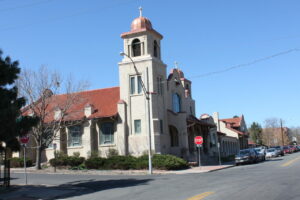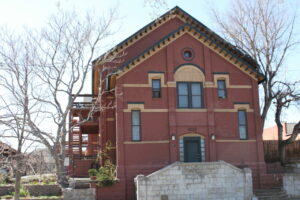By Rebecca A. Hunt
Last month, I shared the history of the middle- and upper-class sections of the near Northside. This month I am taking us down the hill to the area between Zuni Street and the North Platte River and from 15th Avenue up to about 38th Avenue.

One major difference was that this section, called North Denver, was always a Denver neighborhood and was consistently inhabited by immigrants and working-class people. There were immigrants from many parts of Europe, but over time there were three persistent groups that helped shape the cultural face of North Denver. The first group was the Irish, who primarily came from the Catholic-dominated regions of south Ireland.
Some of their neighbors were Scots-Irish who had come from Scotland and were mainly Presbyterian Protestants who had been forcibly relocated from Scotland, some as early as the 1600s. Many were later relocated in the colonial era to the American South, although many of Denver’s Irish arrived in America in the 1840s and 1850s. They were then part of the first generation in Denver in the 1860s.
Since most North Denver Irish residents were Catholics, there was a big push to establish their own churches. The problem was that Bishop Joseph Machebeuf did not like the Irish very much. It took until 1881 for them to get their first church called St. Patrick Catholic Church. Initially, they held services at the fire station at 15th Avenue and Boulder Street.

Their first church was an Italian-style building between 32nd and 33rd avenues on Osage Street. In 1883, the Sisters of St. Joseph of Carondelet set up the first North Denver Catholic school in the church basement. Having a parish school allowed the parents to have more control over their children’s education and moderated their adaptation to American culture. This helped create the first generation of Irish-Americans in Denver.
The first priest was Father Michael Carmody who was replaced in 1885 by Father Joseph Carrigen, who was a real mover and shaker and had quite a few power struggles with Bishop Machebeuf and, later, with Bishop Matz.
During his tenure, Father Carrigen called in a few political favors when Denver was planning the 20th Street viaduct. When all the dust settled, the western end of the bridge came within mere feet of the front doors of St. Patrick’s. At its height, the church had over 750 members and was bursting at the seams.
Father Carrigen took a holiday to California and came back with plans for a California mission style church building, on the corner of 33rd Avenue and Pecos Street, which replaced the old structure in 1907. It served for many years even after part of the congregation had built St. Dominic Church on Federal Boulevard.

In the early 20th century, as the Irish were replaced by the Italians as the dominant ethnic group, St. Patrick closed. It went through a number of new identities, but in the 21st century it is the Our Lady of Light monastery for Capuchin nuns.
North Denver’s Irish were working class who joined unions and the Democratic Party. They bought land and built houses or bought and remodeled the aging neighborhood housing stock. In addition to the initial jobs as laborers, some set up businesses that served the community.
These ranged from grocery stores to saloons. Valuing education, they attended the neighborhood Catholic schools, and then those who could got college educations. Irish American men were policemen and firefighters, and many women became teachers. Some like Dr. Daniel Lucy and later Dennis Gallagher became politicians who shaped the future for both Irish Americans and Northsiders. In January, I will begin to explore the histories of other neighborhoods in the Northside. Berkeley will be my first stop.
Dr. Rebecca A. Hunt has been a Denver resident since 1985. She worked in museums and then taught Colorado, Denver and immigration history at the University of Colorado Denver until she retired in 2020.

Be the first to comment